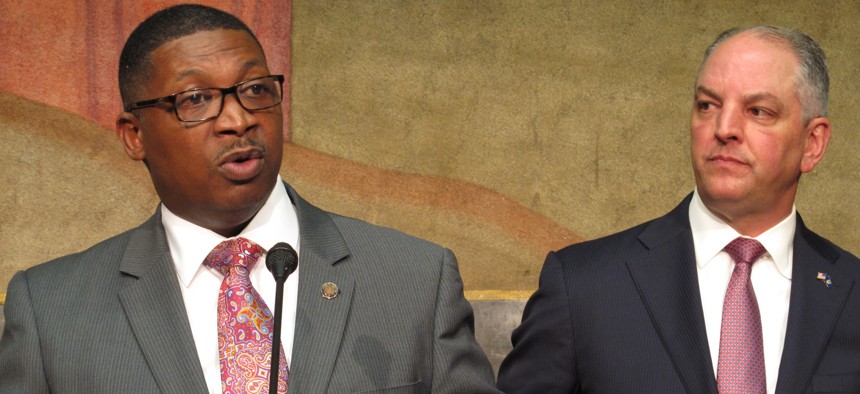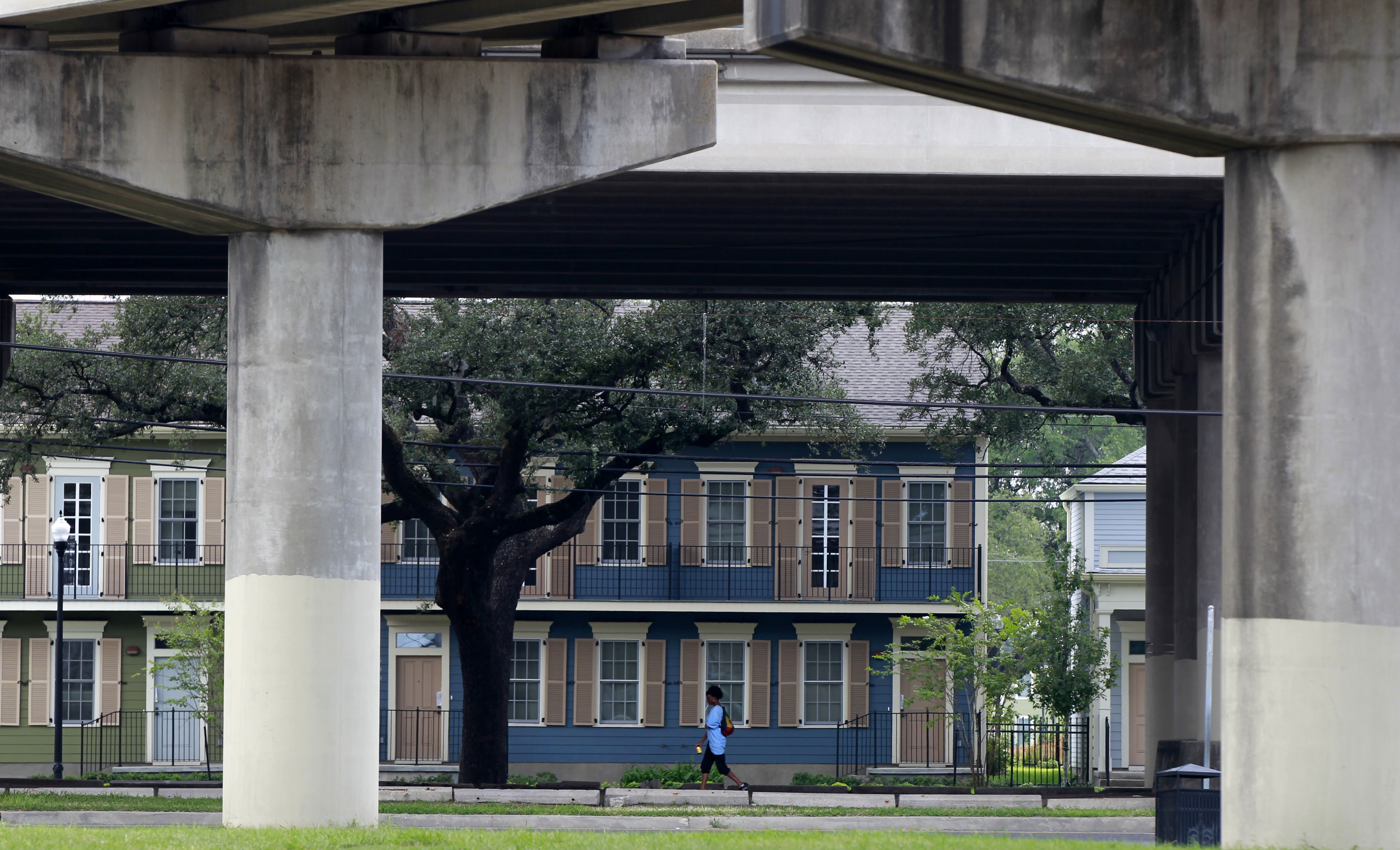Infrastructure Update: Diversity, Equity and State DOTs

Transportation and Development Secretary Shawn Wilson, left, speaks about proposed spending on roadwork as Louisiana Gov. John Bel Edwards listens, in March of 2018, in Baton Rouge, La. AP Photo/Melinda Deslatte
The first Black president of the leading association for state transportation officials speaks with Route Fifty about race, equity and diversity issues confronting public infrastructure agencies.
This is an archived version of Route Fifty's weekly Infrastructure Update newsletter. Subscribe here to receive the newsletter by email.
****
Hello and welcome back to Route Fifty's Infrastructure Update, I'm Dan Vock. Today we're talking with Shawn Wilson, Louisiana's secretary of transportation and development. Wilson recently took over as president of the American Association of State Highway and Transportation Officials. He is the first Black person to hold that position at AASHTO, which has been around for 107 years and is one of the country's most influential transportation industry groups.
Wilson said he hadn't realized how significant it was to him, personally, to become the first Black person to lead AASHTO until he gave a speech to the group as president for the first time. He remembered when he became Louisiana's transportation secretary in 2016, he was the nation's only Black state transportation secretary. (Today, there are six, including officials from California, Illinois, Michigan, Ohio and Washington, D.C.).
"I couldn't explain it," Wilson said, recalling when he gave the speech. "I got more emotional than I ever get in public looking at the other African-American [transportation] secretaries who were in the room … It didn't hit me until later that it was emotional suppression, of holding some of these emotions, thoughts and opinions to myself in a very public space for decades."
He added: "I was standing somewhere that no person of color had ever stood, looking out into that audience and no one in that audience had ever looked at this position and had the perspective of seeing a person of color there."
Wilson said that as a government official in a Republican-leaning state, he had avoided bringing up race and equity issues. "I was focused on ascending the ladder," he told me. "If I had been someone who focused on those issues very intently, very directly and had been very progressive … I don't know if I would have ascended to this position."
Pivotal Moment for Equity Issues
Wilson's elevation to the AASHTO post would be significant at any time, as the world of state DOT leaders has long been dominated by white men. But he happens to be taking the helm just as the federal government is putting a new emphasis on how racial justice is linked to infrastructure. The federal infrastructure debate has sharpened the focus in Washington over how public works projects have hurt Black and other minority neighborhoods at the expense of predominantly white areas. The classic example is interstate highways built through Black communities, often destroying lively business districts, isolating neighborhoods and bringing air pollution and traffic hazards.

I talked with Wilson on the same day he would later travel to the White House to watch President Biden sign the $1.2 trillion Infrastructure Investment and Jobs Act. About $1 billion in that bill is dedicated to reconnecting communities that were harmed by highway construction, but Biden and U.S. Transportation Secretary Pete Buttigieg have talked about incorporating principles of racial justice in other aspects of the department's work as well.
These sorts of developments at the federal level give Wilson a chance to talk plainly about how the transportation industry deals with race and diversity.
Rethinking Diversity at State DOTs
Wilson hopes to help AASHTO and the broader transportation industry do a better job of promoting diversity in its workforce, and in leadership. That effort goes beyond just reaching people of different racial groups, he noted. AASHTO has only had two women as presidents and Wilson wants to do a better job of including LGBTQ people and people of different ethnic backgrounds, as well.
He'd also like to see the industry connecting with more groups affected by its work, including low-income communities and advocates for different modes of transportation.
"We can't just talk to the same contractors and engineers," Wilson said.
Of course, critics of state transportation departments have been calling for similar measures for years. While leadership at the state level has become more diverse, in many cases, states have lagged both local and federal governments in promoting people from different backgrounds to top posts. Wilson said part of the delay here could be explained by the lack of diversity among governors, who appoint state transportation secretaries. People tend to promote those who they know or can identify with, he said, making it harder for women or minority candidates to get political appointments. (There are currently nine women governors and no Black governors.)
Government agencies, Wilson added, are also having a hard time competing with the private sector for talent. And companies, he noted, tend to "understand that there's a business imperative to diversity, equity and inclusion." So this can make it difficult to recruit diverse public sector job candidates in fields like engineering.
Controversial Project in Louisiana
In his home state, Wilson faces a potentially tough decision that raises equity concerns, over whether to move ahead with plans to build a three-mile highway extension, called the Inner City Connector, in a historically Black part of Shreveport. The project has ignited opposition locally, but it is still undergoing environmental reviews.
Shouldn't this be the kind of project that a focus on racial justice would require putting back on the shelf? Wilson wouldn't say. He said he's waiting for the results of those reviews, which take into account community impacts.
He's also weighing whether the project is the best use of the state's finite transportation dollars and how it stacks up against different priorities. "Is it the best and highest use for those communities that are there? Is there a way to redevelop an existing corridor that will add more value to blighted property and to the families that exist there, as opposed to creating new value elsewhere?" he pondered. "Whether we build something or not, we've got to take better care of what's already there. We also have an obligation to move 135,000 people. Where do they go? These are very complex issues."
That's it for this week's edition. If you haven't already, consider signing up here for Route Fifty Today, our daily newsletter, where you can stay up to date on the latest trends and best practices happening in state and local government nationwide. If you have news tips or feedback, if you want to share your community's story, or if you just want to say hello, please email us at: editor@routefifty.com. Thanks for reading!






